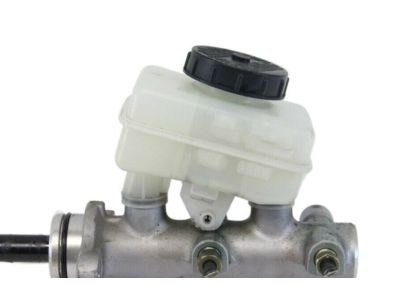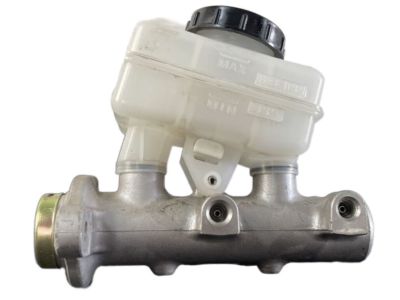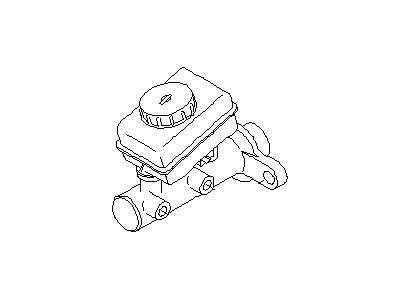×
- Live Chat
- 1-888-726-6993

My Garage
My Account
Cart
Genuine Nissan 350Z Brake Master Cylinder
- Select Vehicle by Model
- Select Vehicle by VIN
Select Vehicle by Model
orMake
Model
Year
Select Vehicle by VIN
For the most accurate results, select vehicle by your VIN (Vehicle Identification Number).
3 Brake Master Cylinders found
Nissan 350Z Cylinder Assy-Brake Master
Part Number: 46010-CD027$288.86 MSRP: $421.20You Save: $132.34 (32%)Ships in 1-3 Business Days
Nissan 350Z Brake Master Cylinder
The Nissan 350Z's Brake Master Cylinder is among the vital parts holding up the braking mechanism; it is the part responsible for translating the pressure applied by the foot into hydraulic pressure. This hydraulic pressure is transmits to the slave cylinders that in turn apply the brake calipers or drums in order to build friction to stop the vehicle. The Nissan 350Z often comes with dual circuit master cylinder sort, a common safety feature which indicates when one circuit wears out the other can continue to supply the car with sufficient brake. It can be made of cast iron or aluminum; with integrated or remote mounted fluid reservoir. In the integral type, there is only one cap and, in the external type, it can be one or two threaded caps. Brake Master Cylinder problems are usually to do with leaking fluids and internal problems which result in the systems' loss of stopping power. This means that the regular inspections for signs of leaks and moisture are critical for the right performance of its braking system in Nissan 350Z.
If you need any OEM Nissan 350Z Brake Master Cylinder, feel free to choose them out of our huge selection of genuine Nissan 350Z Brake Master Cylinder. All our parts are offered at unbeatable prices and are supported by the manufacturer's warranty. In addition, we offer quick shipping to have your parts delivered to your door step in a matter of days.
Nissan 350Z Brake Master Cylinder Parts Questions & Experts Answers
- Q: How do you remove and install a master cylinder in a Nissan 350Z's brake system?A: Brake fluid will damage paint or finished surfaces. Cover all body parts and be careful not to spill fluid during this procedure. Clean up any spilled brake fluid immediately and wash the area with large amounts of water. Disconnect the cable(s) from the negative battery terminal(s). Firmly depress the Brake Pedal several times to remove all vacuum from the power Brake Booster. Clean the Brake Master Cylinder and reservoir thoroughly with brake cleaner. Remove as much fluid as possible from the reservoir with a large syringe. Unplug the electrical connector for the brake fluid level warning switch. Place rags under the fittings and prepare caps or plastic bags to cover the ends of the lines once they're disconnected. Loosen the fittings at the ends of the Brake Lines where they enter the Brake Master Cylinder. To prevent rounding off the corners on the tube nuts, use a flare-nut wrench. Carefully move the brake lines away from the Brake Master Cylinder and plug the ends to prevent contamination. Remove the Brake Master Cylinder mounting nuts. Pull the Brake Master Cylinder off the studs to remove it. Again, be careful not to spill fluid or bend the brake lines as this is done.The primary piston of the Brake Master Cylinder is exposed when the Brake Master Cylinder is withdrawn. Be careful not to damage, strain, or pull on the piston while the Brake Master Cylinder is removed.INSTALLATION: Bench bleed the new Brake Master Cylinder before installing it. Because it will be necessary to depress the Brake Master Cylinder piston and, at the same time, control flow from the brake line outlets, it is recommended that the Brake Master Cylinder be mounted in a vise. If the replacement Brake Master Cylinder is not equipped with a reservoir, remove the reservoir from the old Brake Master Cylinder and place it on the new one using new seals. Attach a pair of Brake Master Cylinder bleeder tubes to the outlet ports of the Brake Master Cylinder. Fill the reservoir with brake fluid of the recommended type. Slowly push the pistons into the Brake Master Cylinder - air will be expelled from the pressure chambers and into the reservoir. Because the tubes are submerged in fluid, air can't be drawn back into the Brake Master Cylinder when you release the pistons. Repeat the procedure until no more air bubbles are present. Remove the bleed tubes, one at a time, and install plugs in the open ports to prevent fluid leakage and air from entering the system. Install a new O-ring seal in the groove on the end of the Brake Master Cylinder and coat it with silicone grease. Continue to grease the entire area from the O-ring to the end of the Brake Master Cylinder that is inserted into the power brake booster. Also, coat the bore of the booster itself. Install the reservoir cover and remove the Brake Master Cylinder from the vise. Using a new gasket on the Brake Master Cylinder, install the Brake Master Cylinder over the studs on the power brake booster and tighten the attaching nuts only finger tight at this time. Thread the brake line fittings into the Brake Master Cylinder until they are finger tight. Tighten the mounting nuts, then tighten the brake line fittings securely. Fill the Brake Master Cylinder reservoir with the correct fluid, then bleed the brake system. To bleed the Brake Master Cylinder on the vehicle, have an assistant pump the brake pedal several times slowly, then hold the pedal to the floor. Loosen the line fittings one at a time to allow air and fluid to escape. Repeat this procedure on both fittings until the fluid is clear of air bubbles. Have plenty of rags on hand to catch the fluid. Brake fluid will ruin painted surfaces. Wash off spilled fluid with plenty of water. The remainder of installation is the reverse of removal. Test the operation of the brake system carefully before placing the vehicle into normal service.








